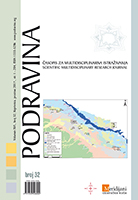- TOPOGRAFIJA ARHEOLOŠKIH LOKALITETA S TALIONIČKOM DJELATNOŠĆU NA PROSTORU PODRAVINE
- GRADEC (GERECZ) – SREDNJOVJEKOVNO PODRAVSKO VLASTELINSTVO
- LESS-KNOWN BOSNIAN CAMPAIGN DURING THE 1566 SIEGE OF SZIGETVÁR
- SABLJA SIGETSKOG NIKOLE IV. ZRINSKOG
- »LEGRADSKA I MEĐIMURSKA KAPETANIJA« - DODACI VOJNOJ SLUŽBI NIKOLE VII. ZRINSKOG
- KRAJIŠKA NASELJA UZ RIJEKU DRAVU NA PODRUČJU ĐURĐEVEČKE PUKOVNIJE NA KRAJU 18. STOLJEĆA
- UZROCI I POSLJEDICE MNOGOSTRUKE SURADNJE NAŠIH KRAJEVA UZ DRAVU S REGIJAMA OD 1868. DO 1931. TJ. OD HRVATSKO-UGARSKE NAGODBE DO VELIKE SVJETSKE KRIZE
- STRADANJE ROMA U LUDBREGU ZA VRIJEME DRUGOGA SVJETSKOG RATA
- NASELJE KOPRIVNICA - SUVREMENI DEMOGRAFSKI IZAZOVI
- DEVELOPMENT OF FAMILY TOURISM BUSINESSES IN RURAL AREAS: MULTI CRITERIA ASSESSMENT OF BUSINESSES IN EASTER SLOVENIA
- EKOSISTEMSKE ZNAČILNOSTI KRAŠKE JAME BELOJAČE V PODRAVSKI REGIJI
- MARGINALNOST KAO ZNANSTVENO-ISTRAŽIVAČKA TEMA U GEOGRAFIJI - S OSVRTOM NA MEĐIMURJE
- PRIKAZI NOVIH KNJIGA, ČASOPISA I ZNANSTVENIH SKUPOVA
- UPUTE SURADNICIMA
LESS-KNOWN BOSNIAN CAMPAIGN DURING THE 1566 SIEGE OF SZIGETVÁR
Though the magnitude of the presented Christian military ventures in the Croatian-Venetian perimeter should not be overrated, it is worth noting that the attacks against Novi Grad and Kostajnica took place during the sieges of Szigetvár and Gyula, which must have been a serious disruption to the Ottoman military command; Ákos Csányi’s letter dated August 31 states that 4000 cavalrymen from the camp besieging Szigetvár were recalled to Constantinople. This information is most probably false, the unit in question actually being the Turkish rescue army that arrived at the Sava to aid against the assault of the Hungarian troops. Apart from the numbers and the Bosnians’ involvement, the timelines also match. It suggests that archduke Charles not only led a successful campaign in the Turkish borderlands in Bosnia, but they also managed to divert major forces from the siege of Szigetvár. It is not their fault, however, that despite long-nurtured plans, neither Maximillian’s troops in Győr, nor the other unit in Komárom followed suit and they never launched counterattacks against Esztergom, Visegrád or Székesfehérvár. The tactics that had been successfully employed during 1555-56, namely disrupting a Turkish campaign by attack on a stronghold or by nearby mobilization, was abandoned everywhere in 1566, except in the Croatian borderlands.
Prethodno priopćenje / Preliminary communicationZoltán PÉTER BAGI

